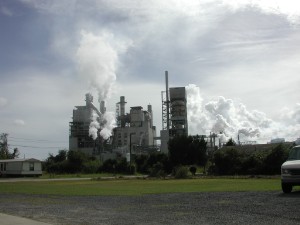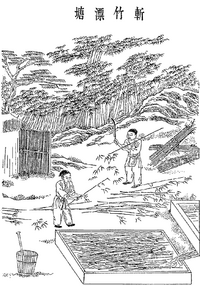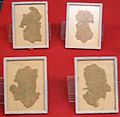Paper facts for kids
Paper is a thin, flat material usually made from wood fibres. We use it for many things, like writing and printing. Think of all the books, newspapers, and magazines you see – they're all made of paper! Paper can also soak up liquids, which is why we use it for cleaning. There are many different types of paper, each with its own special use.
The pulp and paper industry includes companies that turn wood into pulp, paper, and other products made from cellulose.
Contents
How Paper is Made
Most modern paper is made from wood pulp. First, wood is ground up and mixed with water and other chemicals. This creates a thin, soupy liquid called "paper pulp."
To make paper whiter, the pulp can be bleached. If you want colored paper, dyes can be added to the pulp. This liquid pulp is then pressed into thin sheets of paper.
Often, printing is done on large rolls of paper before they are cut into smaller sheets. For example, newsprint paper (used for newspapers) comes in huge rolls. It goes through the printing process as one long, continuous sheet. Later, a machine with a guillotine blade cuts it into newspaper-sized pieces. Folding comes next, and then the newspapers are packed for delivery.
Sometimes, paper is made heavier and more glossy (shiny). This is done by adding clay and by 'milling' it. Milling means squeezing the paper through a series of rollers. Also, a lot of paper today is made from used or waste paper. This process is called recycling, and it helps save trees!
Not all paper is made from wood. Other types of fibers can be used too. For special purposes, people still make paper from materials like cotton, linen, and hemp.
The History of Paper




People started writing long before paper was invented. They wrote on many different materials. For example, they wrote on cloth, on stone walls, and on wood. In Mesopotamia, the Sumerians wrote on clay tablets, and many of these have survived to this day. In Europe, people often wrote on vellum, which was made from animal skin.
The Very First Paper
Many centuries ago, as early as 2000 BC, people in Egypt made a type of paper from the papyrus plant. This is where the word 'paper' comes from! The people of Greece and Rome also learned how to make and use papyrus. The Romans also wrote on parchment (made from animal skin), on waxed tablets, and on wood.
In China, around 105 AD, a court official named Cai Lun told his Emperor that he had created paper. Before this, the Chinese used bamboo and silk for writing. The materials used in this early Chinese paper included cotton rags, hemp, various plant fibers, and even old fish nets.
The oldest piece of paper with writing on it was found in the ruins of a watchtower on the Great Wall of China. It dates back to about 150 AD. Even older paper (without writing) has been found, dating from between 140 and 87 BC. The Chinese considered paper-making to be so valuable that they kept the process a secret for as long as they could.
How Paper Spread Around the World
People in Japan learned how to make paper from the fibers of the mulberry tree around 610 AD. This special paper is known as Japanese paper or Washi. From China, the invention of paper-making spread to India, then to the Middle East, and finally to Italy.
A big opportunity for paper to spread happened after the Battle of Talas in 751 AD. An Arab army captured some Chinese soldiers, and among them were paper makers. From these captured soldiers, paper-making spread throughout the Islamic world. In 757 AD, a paper mill was built in Samarkand. People there learned to use linen as a raw material for paper and to use starch from flour as an additive.
The Italians started using hemp and linen rags to make paper. In 1276, the first Italian paper mill was built in Fabriano. Until the 14th century, Italy was a major supplier of paper in Europe. In 1282, the first watermark was introduced in Bologna, Italy.
Paper Made by Machines
Making paper by hand was very difficult and slow. While it was cheaper than older writing materials, it was still expensive. A machine to make paper was thought of in France in 1798, but it was actually invented in England. By 1812, at least one paper mill was using these machines. This made the paper-making process much cheaper, but the raw materials were still costly.
In 1840, Friedrich Gottlob Keller invented a machine that could make pulp for paper from wood fibers. This was a huge step because it meant paper no longer had to be made from expensive rags. Paper became cheap enough for almost everyone to buy!
Around the same time, other important inventions were made, like the pencil, the fountain pen, and printing presses that used steam power. With all this new information technology, people wrote more letters, made more books and newspapers, and kept more records of what they did.
Today, some of the largest paper-producing countries include China, the USA, Canada, Finland, Sweden, and Russia. Paper is produced in huge factories called paper mills, which make hundreds of thousands of tons of paper every year.
What We Use Paper For
Paper is mainly used for writing and printing. Books, magazines, and newspapers are all printed on paper.
Paper is also often used for money. The paper used for money is made in very special ways. It doesn't use wood fiber; instead, it's mostly cotton with special additives. These additives make it very difficult for people to print their own money. A piece of paper money is called a banknote, a bill, or a note.
Paper can be used for cleaning too. Special forms of paper are made for this, such as paper towels, facial tissues, or toilet paper.
Pretty paper can be used as decoration. You can paste it onto the walls of a room, which is called wallpaper. Paper is also used to wrap gifts, and this is known as wrapping paper or gift wrap.
Some types of paper are very strong and are used to make boxes and other packaging material. Sometimes, several layers of paper are glued together to create cardboard, which is even stronger.
Related Pages
Images for kids
-
Hemp wrapping paper, China, c. 100 BC
-
A paper mill in Mänttä-Vilppula, Finland
-
Card and paper stock for crafts comes in many textures and colors
See also
 In Spanish: Papel para niños
In Spanish: Papel para niños










